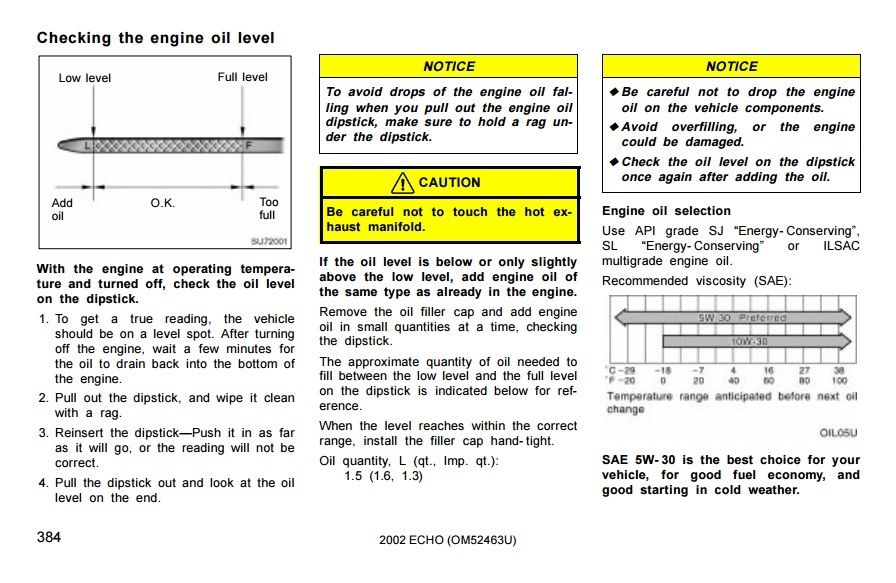Originally Posted By: OVERKILL
Originally Posted By: philipp10
by some of the logic I have seen here, if I wanted to be really cheap, I would do my oil changes and fill it to just 1/4 quart above the bottom of the low range on my dipstick, then just keep it there thru the OCI. At the end, I would save 3/4 quart on every change. The flaw in the thinking is, I am then running about 18% low on my oil ALL the time. Therefore, would I not then have to reduce my OCI by 18%? In effect, keeping the sump full, especially topping off an oil burner should allow for longer OCI's, right?
That's an interesting theory but a few things:
1. The manufacturer specifies an initial fill capacity when you do an oil change. And then advises you ensure that the level is above the low mark or you add oil when you reach the low mark or you maintain the oil level between the marks depending on the verbiage in the manual. This is in-line with the discussion so far. Nobody has advocated a lower capacity initial fill in an attempt to save money, though it is a process used in some drag racing efforts (a quart low) to reduce windage and wring every last pony out of an engine. Of course that's not about saving money or oil though.
2. Most people don't do UOA's so they don't know how long they can safely run whatever oil they've chosen in the first place. So your 18% is 18% of a number that has no actual reference point.
3. Engine A and Engine B both the same make and model of engine in the same make and model of car can have very different consumption rates. If engine A consumes 2L per 8,000Km and engine B consumes 1L per 8,000Km then engine B should run a shorter OCI based on your logic here. But of course we know that's not the case. Oil consumption is what it is on a new engine and the recommended OCI is either a set mileage or follows an OLM, something that doesn't factor oil level into the equation (unless perhaps it is a new BMW that has the electronic oil level sensor).
4. Chronic oil burning engines are usually the least healthy; they have blow by and are constantly contaminating the oil with fuel and combustion byproducts negating at least some of the benefit of the frequent top-ups you are doing. As I noted in one of my earlier posts, the healthiest engines I've owned consume little to no oil between change intervals and analysis has shown that, despite the lack of top ups, that the lubricant is fit for continued use when I've changed it. Which brings us back to point 1.
5. In-line with your cost point, some engines are inclined to sip a bit of oil when it is at the max mark on the dipstick but once it gets down 1/2 a quart or so, the consumption slows significantly or stops (I believe an individual mentioned one of their cars does that in this thread, and that is not the first time I've heard it). This may be due to windage, sump design...etc. It doesn't really matter the cause, the point is that it happens. Now, if that person is inclined to keep the oil AT the full mark, and obsessively checks it, then they are going to be doing more frequent top-ups, using more oil, and subsequently costing themselves more money. If, on the other hand they were to let it get that 1/2 quart low and it stabilizes there and stays there for the OCI, that is a cost savings.
My whole point here is that the OEM will advocate a particular process. Many will follow that process. Some, who are perhaps more inclined to doing things their way, will not follow that process and ultimately end up no further ahead than those that do. If it makes them feel better, that's great. I'm not condemning the practice, but I see no tangible benefit over what the OEM advocates. What I do see is one detractor and that is that the more frequently you open that oil cap to top up, the higher the risk of introducing contaminants into the sump. I'm sure we are all quite anal about adding oil out of the wind, wiping off all the surfaces before we do....etc. But like with opening an intake tract, no matter how careful we are, some foreign debris is going to enter. Is it significant? Probably not. But something to consider

For the sake of argument here, let’s compare 2 cars. Car 1 has a 5 quart sump. Car 2 has 500 quart sump (yes, 100x as much). Now if I run both cars 10K miles and do an oil analysis, what do you suppose I would find? Car 1 with the small sump would have X% contaminates in the oil. Would not car 2 have X% contaminates divided by 100? Therefore wouldn’t the OCI of car 2 be 100x the OCI of car 1?
Keeping the sump full effectively extends the OCI due to more oil per contaminates. How can it not be true?







